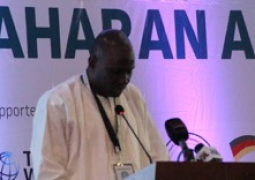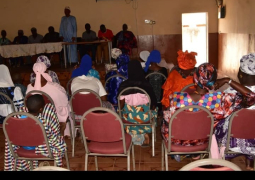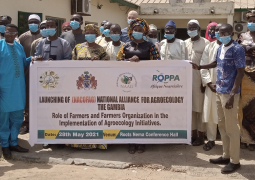His Excellency President Adama Barrow’s keynote address for the launching was read by the Honorable Minister of Environment, Climate, Change and Natural Resources, Mr. Lamin B. Dibba.
Upon the launching, the African Union issued a press release by Her Excellency Ambassador Joseafa Leonal Correia Sacko, Commissioner, Department for Rural Economy and Agriculture; and it reads:
“My fellow Africans! I am pleased to issue this press briefing at the launch of the Inaugural Africa Report on Disaster Risk Reduction. As you might be aware, disasters have become a recurrent phenomenon in Africa and the Africa Union wants to ensure that countries are prepared to minimize the losses from these natural hazards hence the DRR Unit embarked on this work. This is the first report since the adoption of the Programme of Action for implementation of the Sendai Framework for Disaster Risk Reduction 2015-2030 by the African Union.
As you might have observed in the presentation during the launch, this Report covers the period 2015-2018, using 2015-2016 as the baseline. It measures Africa’s progress on 12 targets (7 global and 5 specific to Africa). Among these targets are reduction of disaster mortalities, economic losses, losses to critical infrastructures and disruption of basic services, increasing domestic resources allocation.
Comparing the two periods (2015-2016) and (2017-2018), the report highlights the following:
- Africa risk profile is increasing:
- Hazards are increasing. The number of disasters increased from 311 in 2015-2016 to 474 in 2017-2018.
- Vulnerability and exposure are increasing.
- Coping capacity is declining.
- Disaster mortalities increased from over 31,000 in 2015-2016 to more than 36,000 in 2017-2018
- However, the number of affected people, I am glad to report, decreased from over 58 million in 2015-2016 to 22 million in 2017-2018
- Economic losses increased from 2 billion in 2015-2016 to 8 billion in 2017- 2018
- Only 22% of the 50 Countries that participated have DRR strategies in place and 5% of those with strategies are fully implementing them
- In terms of other targets that are specific to Africa, only 1 country (Rwanda) is fully on track. Other countries such as Ghana, Algeria, Kenya, and Sudan have made important progress. Kindly refer to the dash board in the report for further details.
As evidenced in the summary above, disasters are on increase and driven mostly by climate change and variability. Natural degradation is also adding another layer to the occurrence of hazards, facilitating even viruses such as Coronavirus to cross species boundary in order to infect humans.
The AU Commission is committed to reducing disaster risks and losses. As an Agronomist, I associate resilience with food security. One of my priorities has been building resilience to Disaster and Climate risks which continue to impact our continent. Drought, floods and pests are some of the hazards threatening food security in Africa. In my interactions with African Ministers responsible for Disaster Risk Reduction at global and Africa’s fora, I have always insisted that Disaster Risk Reduction is a matter of survival and that resilience building must be our ways of life.
In conclusion, I call upon our member states and RECs to continue to put more efforts on reducing disaster risks and further request our development partners to enhance collaboration on disaster risk reduction.”





